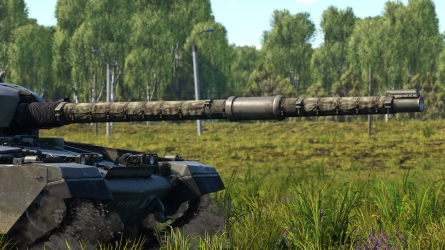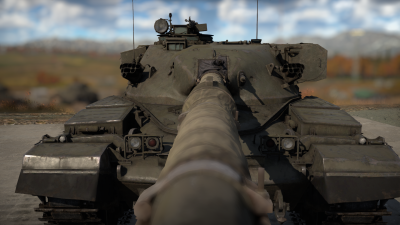Difference between revisions of "Ordnance BL Tk. L11A5 (120 mm)"
Panzerzwerg (talk | contribs) m (→History) (Tag: Visual edit) |
m (U38088265 moved page Ordnance BL Tk. L11 (120 mm) to Ordnance BL Tk. L11A5 (120 mm): Renamed in-game) |
||
| (2 intermediate revisions by the same user not shown) | |||
| Line 18: | Line 18: | ||
=== Available ammunition === | === Available ammunition === | ||
| + | <!-- ''Describe the shells that are available for the weapon and their features and purpose. If it concerns autocannons or machine guns, write about different ammo belts and what is inside (which types of shells).'' --> | ||
| + | |||
{{:{{PAGENAME}}/Ammunition|Shot L15A3, Shell L31A7, Shot L23, L34}} | {{:{{PAGENAME}}/Ammunition|Shot L15A3, Shell L31A7, Shot L23, L34}} | ||
| Line 31: | Line 33: | ||
'''Pros:''' | '''Pros:''' | ||
| − | * | + | * APDS round has high penetrating power, able to defeat all but the most heavily armoured MBTs it encounters. |
| − | * Has access to HESH ammunition, being capable | + | * Has access to HESH ammunition, being capable to hull-break lightly armoured vehicles |
| − | * The L21A1 12.7 mm Heavy Machine Gun can be used alongside with the main gun to accurately rangefind targets | + | * The L21A1 12.7 mm Heavy Machine Gun can be used alongside with the main gun to accurately rangefind targets due to the similar ballistic performance of both rounds. |
* Late vehicles (namely the Chieftain Mk 10) have access to APFSDS ammunition | * Late vehicles (namely the Chieftain Mk 10) have access to APFSDS ammunition | ||
| Line 42: | Line 44: | ||
== History == | == History == | ||
| − | + | ''Examine the history of the creation and combat usage of the weapon in more detail than in the introduction. If the historical reference turns out to be too long, take it to a separate article, taking a link to the article about the weapon and adding a block "/History" (example: <nowiki>https://wiki.warthunder.com/(Weapon-name)/History</nowiki>) and add a link to it here using the <code>main</code> template. Be sure to reference text and sources by using <code><nowiki><ref></ref></nowiki></code>, as well as adding them at the end of the article with <code><nowiki><references /></nowiki></code>.'' | |
| − | |||
| − | |||
| − | |||
| − | |||
== Media == | == Media == | ||
| Line 58: | Line 56: | ||
== See also == | == See also == | ||
''Links to the articles on the War Thunder Wiki that you think will be useful for the reader, for example:'' | ''Links to the articles on the War Thunder Wiki that you think will be useful for the reader, for example:'' | ||
| − | |||
* ''reference to the article about the variant of the cannon/machine gun;'' | * ''reference to the article about the variant of the cannon/machine gun;'' | ||
* ''references to approximate analogues by other nations and research trees.'' | * ''references to approximate analogues by other nations and research trees.'' | ||
== External links == | == External links == | ||
| + | ''Paste links to sources and external resources, such as:'' | ||
| + | * ''topic on the official game forum;'' | ||
| + | * ''other literature.'' | ||
| + | |||
| + | {{Britain tank cannons}} | ||
| + | |||
[[Category:Tank cannons]] | [[Category:Tank cannons]] | ||
| − | |||
| − | |||
| − | |||
Revision as of 15:35, 14 December 2023
Contents
Description
The Ordnance BL Tk. L11 is a British 120 mm rifled cannon derived from the Conqueror's L1A2 120 mm main gun. This powerful gun was meant to be used in the Chieftain series Main Battle Tank, in-game this cannon is present on the Mk 3, Mk 5 and Mk 10 variants of this vehicle. At time of production, the L11, firing armour-piercing discarding sabot rounds (APDS), was one of the most fearsome anti-tank solutions present in an Armoured Fighting Vehicle and thus, fulfilled its purpose to defeat the 60s Soviet armour.
Vehicles equipped with this weapon
General info
Tell us about the tactical and technical characteristics of the cannon or machine gun.
Available ammunition
| Penetration statistics | |||||||
|---|---|---|---|---|---|---|---|
| Ammunition | Type of warhead |
Penetration @ 0° Angle of Attack (mm) | |||||
| 10 m | 100 m | 500 m | 1,000 m | 1,500 m | 2,000 m | ||
| Shot L15A3 | APDS | 298 | 296 | 288 | 277 | 268 | 258 |
| Shell L31A7 | HESH | 152 | 152 | 152 | 152 | 152 | 152 |
| Shot L23 | APFSDS | 410 | 408 | 405 | 400 | 390 | 380 |
| Shell details | ||||||||||||
|---|---|---|---|---|---|---|---|---|---|---|---|---|
| Ammunition | Type of warhead |
Velocity (m/s) |
Projectile mass (kg) |
Fuse delay (m) |
Fuse sensitivity (mm) |
Explosive mass (TNT equivalent) (kg) |
Ricochet | |||||
| 0% | 50% | 100% | ||||||||||
| Shot L15A3 | APDS | 1,372 | 7.48 | - | - | - | 75° | 78° | 80° | |||
| Shell L31A7 | HESH | 670 | 17.34 | 0.1 | 4 | 6.53 | 73° | 77° | 80° | |||
| Shot L23 | APFSDS | 1,535 | 3.89 | - | - | - | 78° | 80° | 81° | |||
| Smoke shell characteristics | ||||||
|---|---|---|---|---|---|---|
| Ammunition | Velocity (m/s) |
Projectile mass (kg) |
Screen radius (m) |
Screen deploy time (s) |
Screen hold time (s) |
Explosive mass (TNT equivalent) (g) |
| L34 | 670 | 17.1 | 20 | 5 | 25 | 50 |
Comparison with analogues
Give a comparative description of cannons/machine guns that have firepower equal to this weapon.
Usage in battles
Describe the cannon/machine gun in the game - its distinctive features, tactics of usage against notable opponents. Please don't write a "guide" - do not impose a single point of view, but give the reader food for thought.
Pros and cons
Pros:
- APDS round has high penetrating power, able to defeat all but the most heavily armoured MBTs it encounters.
- Has access to HESH ammunition, being capable to hull-break lightly armoured vehicles
- The L21A1 12.7 mm Heavy Machine Gun can be used alongside with the main gun to accurately rangefind targets due to the similar ballistic performance of both rounds.
- Late vehicles (namely the Chieftain Mk 10) have access to APFSDS ammunition
Cons:
- Slightly less accurate than smoothbore counterparts
- HESH shells produce little spalling, making them impracticable to fight heavy vehicles
History
Examine the history of the creation and combat usage of the weapon in more detail than in the introduction. If the historical reference turns out to be too long, take it to a separate article, taking a link to the article about the weapon and adding a block "/History" (example: https://wiki.warthunder.com/(Weapon-name)/History) and add a link to it here using the main template. Be sure to reference text and sources by using <ref></ref>, as well as adding them at the end of the article with <references />.
Media
- Images
See also
Links to the articles on the War Thunder Wiki that you think will be useful for the reader, for example:
- reference to the article about the variant of the cannon/machine gun;
- references to approximate analogues by other nations and research trees.
External links
Paste links to sources and external resources, such as:
- topic on the official game forum;
- other literature.
| Britain tank cannons | |
|---|---|
| 30 mm | L21A1 |
| 40 mm | QF 2-pounder |
| 47 mm | Ordnance QF 3-pounder |
| 57 mm | 6pdr OQF Mk.III · 6pdr OQF Mk.V |
| 75 mm | OQF Mk.V |
| 76 mm | OQF 3-inch Howitzer Mk I · OQF 3in 20cwt · QF 17-pounder |
| 77 mm | OQF Mk.II |
| 84 mm | 20pdr OQF Mk.I |
| 94 mm | 28pdr OQF · 32pdr OQF · OQF Mk.II |
| 95 mm | Howitzer, Tank No.1, Mk.I |
| 105 mm | LRF · Royal Ordnance L7A1 |
| 120 mm | Ordnance QF Tk. L1A2 · Ordnance BL Tk. L11 · L11A5 · L30A1 |
| 165 mm | ORD BL 6.5in L9A1 |
| 183 mm | QF L4A1 |
| Foreign: | |
| 25 mm | M242 (USA) |
| 37 mm | M5 (USA) · M6 (USA) |
| 75 mm | M2 (USA) · M3 (USA) |
| 84 mm | kan Strv 81 (Sweden) |
| 105 mm | Sharir (Israel) |
| 120 mm | Rh120 L/55 A1 (Germany) |
| 125 mm | 2A46M-5 (Russia) |
| 155 mm | M185 (USA) |
| South Africa | |
| 20 mm | GI-2 |
| 76 mm | GT-4 |
| 90 mm | GT-2 |
| 105 mm | GT-3 · GT-7 · GT-8 |
| 155 mm | G6 L/45 |





